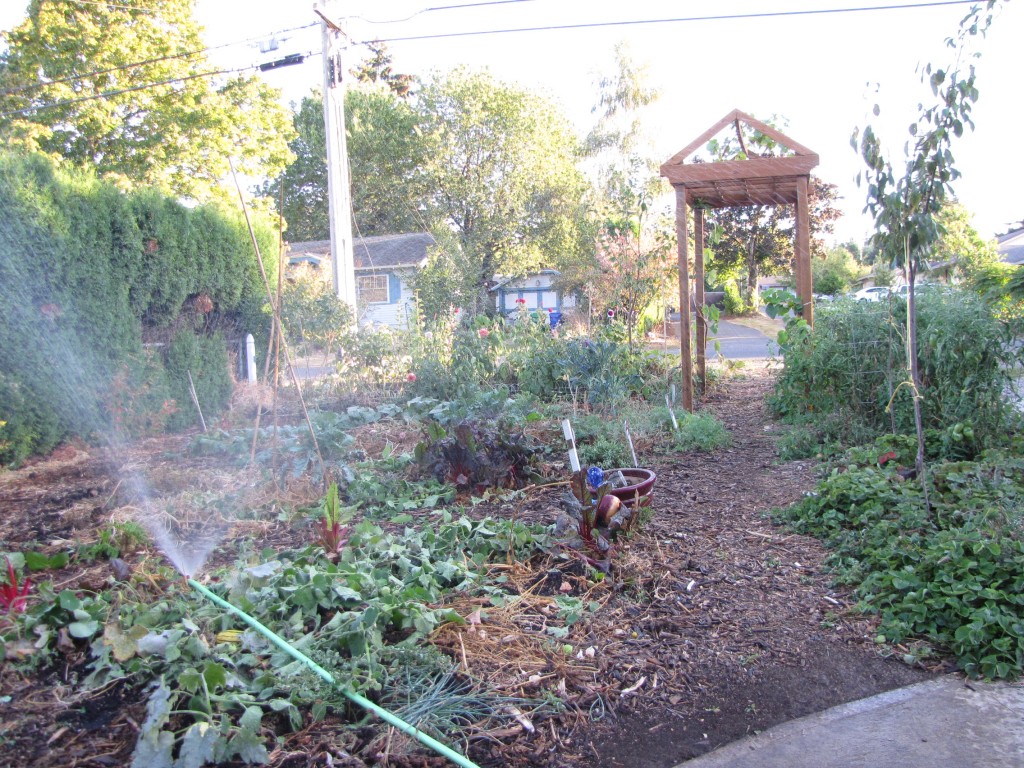This past weekend, we finally got around to planting cover crops in the front yard garden (and this coming weekend, after fencing off sections from marauding poultry, we’ll sow the backyard).
These are Austrian peas. I’m trying them for the first time, along with several other cover crops we’ve used before.
It’s a bit of a mess, isn’t it? Well, before sowing cover crops, we pulled up all existing annual food plants (the exception is a few Vulcan Chard plants that are producing well, and the tomatoes in the far right. They will be removed this weekend when we plant garlic there).
Following permaculture principles, we strive to utilize everything in our system, so we “chop and drop” spent plants and throw them back on the beds to return their nutrients to the soil and build up the humus. It hasn’t rained here in ages, so we watered afterward.
Then it was time to plant a mix of cereal rye, crimson clover, hairy vetch, red clover and field peas, and water them in well. We purchased them in bulk at the feed store, and spent less than $3 for enough to cover all the front beds (except the future garlic bed).
Ordinarily, cover crops (like the rye above) are allowed to grow all fall and winter, and then are tilled into the soil in spring (before they set seed and essentially become weeds). Well, the soil is a living, complex ecosystem, which we try not to disturb, so we do not till.  We build up the soil, always adding to the top, but not disturbing the mycelium and other organisms in the lower layers. How do we finish off the cover crop and prepare for planting in the spring?
The answer: We let the poultry do it for us. While the crops are germinating, we use temporary fencing to secure them from the ducks and chickens, but once they are mature, we remove sections of the fencing, and allow the poultry to feast.
In this way, we
1) reduce our personal energy output (we do not have to spend the time tilling in the vetch, rye and such)
2) reduce our winter poultry feed bill
3) minimize disturbance of the soil ecology
4)massively reduce the slug population as the ducks forage through the cover crops for their favorite treat.
5) enhance the aeration and fertility of the soil as the roots and inedible parts of the cover crops breakdown, and the birds contribute their rich manure.
In small areas of the garden we do not plant cover crops (mostly in the large backyard, not the little front yard shown here), but instead grow some winter produce for our family (chard, kale, cauliflower, etc) as well as many rows of garlic and shallots. Those areas will receive an addition of well-composted chicken/ duck manure + straw from the coops before the spring planting.
More on garlic cultivation and our slow permie progression from annual to perennial crop cultivation in next week’s posts.
What are your fall and winter plans for your garden?






Hi Angela, I’m Anne from Life on the Funny Farm (http://annesfunnyfarm.blogspot.com) visiting from the blog hop. Great instructions! Love the use of the chickens with the garden. So smart! Pop over and say hi sometime if you get the chance. Nice to “meet” you!
I love your plans! So smart. Hopefully I’ll get the chickens in our garden at some point. For now, I still have a lot of cabbage, peas, lettuce and garlic going.
Hi there. I’m stopping in for the first time via the Tues Archive Link-Up. Mine is a food blog if you’re interested in taking a peek sometime (http://hyethymecafe.blogspot.com/). I have to confess, I feel like I’m in the wrong place, being one with a black rather than green thumb! 🙁
Had to laugh at the Crimson Clover though – I’m probably dating myself (not quite older than dirt), but I’m going to be singing the Tommy James and the Shondel’s song Crimson and Clover in my head for the rest of the day now LOL. (I’ve never heard of Austrian peas, but I’m curious about that now and will have to investigate.)
What a great garden! I am slowly working toward a permaculture set up at our new house (just moved in) At the moment I am planting garlic and onions and some berries in hopes they will take root before the first snow (predicted to come this Friday!)
I would love it if you would share this post on my new blog hop Natural Living Monday! I know my readers would too.
Thanks so much!
http://wp.me/p2pBvv-xX
Sounds like you guys have a good balance figured out on how to care for and benefit from your garden. Thanks for sharing on Tuesday Greens!
What perfect timing! I saw your comment over at This Blessed Life on Rootsong Farm. Decided to swing by to visit. I am so glad I did! We are trying our best to get things working in a sustainable way. We want to feed the soil, build it up. We had a very hit and miss garden this year. It didn’t help that some of our goats found a weak spot in our fencing. Yeah, that took care of the rest of the garden! Oy. I’ll have to see if our feed store carries seed. I never thought to ask.
Have a wonderful day.
Kerri
Thanks for the great info on cover crops; here in Florida we are putting in different greens, growing garlic throughout the garden and harvesting moringa leaves for morning tea. I have been using red clover and alfalfa for cover crops and for making fertilizer tea.
Pingback: Stockmar afternoon | Salt of the Earth Urban Farm